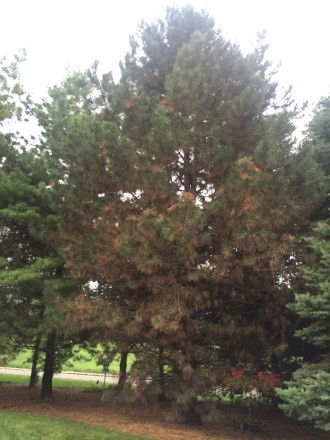Diplodia Tip Blight of Two-Needled Pines

Diplodia tip blight is commonly found in Austrian pines. Since this plant isn’t native to the area it is highly susceptible to this fungus. Typically what happens is the tree will lose all of its older growth, (needles on the inside of the tree) so it looks very sparse. Only 1-3 years of growth will remain on the end of the branch but it should have about 8 years of growth on a healthy branch.
There are a few things you can do to help prevent the spreading of this fungus. Raking up the needles to remove extra fungus spores will help reduce the spread of the fungus. Pruning your lower branches off will make it harder for spores to reach the tree. Deep root fertilizing your tree will increase the length of the 1-3 years of growth on a branch, giving it a fuller look. You can also prune out heavily diseased portions of the tree to minimize the fungus. Lastly, you can spray fungicide on the tree in the spring. This needs to be done every 10-14 days to ensure proper coverage of elongating buds.
Spraying the tree for the fungus doesn’t do what most people think it will. It doesn’t “cure” the tree of the problem; it only prevents the spread of it. Fungicide is a good preventative method to protect the new shoots as they develop in the spring time. After the spring is over, it is important to clean up fallen needles and raise lower branches from the ground to minimize all the fungus spores. Although Diplodia tip blight looks bad, it would need a very heavy infestation to kill the tree. Typically a tree will live for years with this fungus by outgrowing the problem. Drought, excessive water, or other infesting insects usually finish off the tree.
If you see excessive brown needles on any conifer, contact your local Arborist and have a free evaluation done on your property to ensure the longevity of your trees!